Financial Accounting Factors for Superannuation Plans in Australia
VerifiedAdded on 2021/06/17
|9
|2369
|23
Essay
AI Summary
This essay provides a comprehensive overview of the financial factors that tertiary employees in Australia should consider when deciding between a defined benefit plan and an investment choice plan for their superannuation contributions. It begins by explaining the compulsory nature of superannuation in Australia and the government's role in regulating these plans to protect contributors' interests. The essay then delves into the factors that employees must evaluate, such as the legal agreements between employers and scheme firms, the duration of the scheme's operation, insurance coverage, risk levels, and the impact of age and government interventions. The essay also emphasizes the importance of considering the time value of money and tax implications, including tax exemptions and the consequences of early withdrawals or investment transfers. The author highlights that the choice of a superannuation plan depends on individual circumstances, including income and financial goals, urging employees to seek advice from employers or the Australian Tax Office. The essay concludes by reinforcing that informed decision-making is crucial for securing financial well-being in retirement.
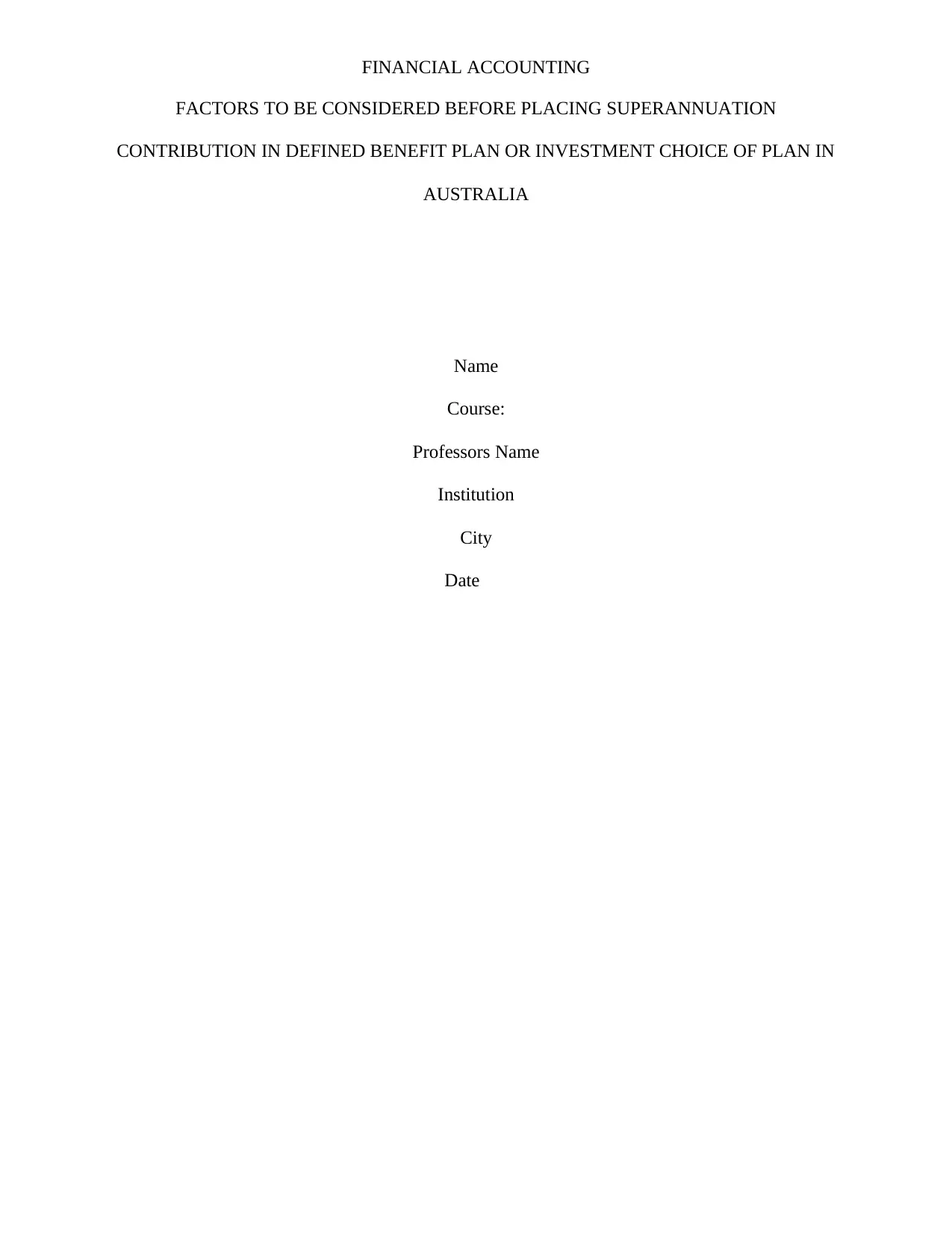
FINANCIAL ACCOUNTING
FACTORS TO BE CONSIDERED BEFORE PLACING SUPERANNUATION
CONTRIBUTION IN DEFINED BENEFIT PLAN OR INVESTMENT CHOICE OF PLAN IN
AUSTRALIA
Name
Course:
Professors Name
Institution
City
Date
FACTORS TO BE CONSIDERED BEFORE PLACING SUPERANNUATION
CONTRIBUTION IN DEFINED BENEFIT PLAN OR INVESTMENT CHOICE OF PLAN IN
AUSTRALIA
Name
Course:
Professors Name
Institution
City
Date
Paraphrase This Document
Need a fresh take? Get an instant paraphrase of this document with our AI Paraphraser
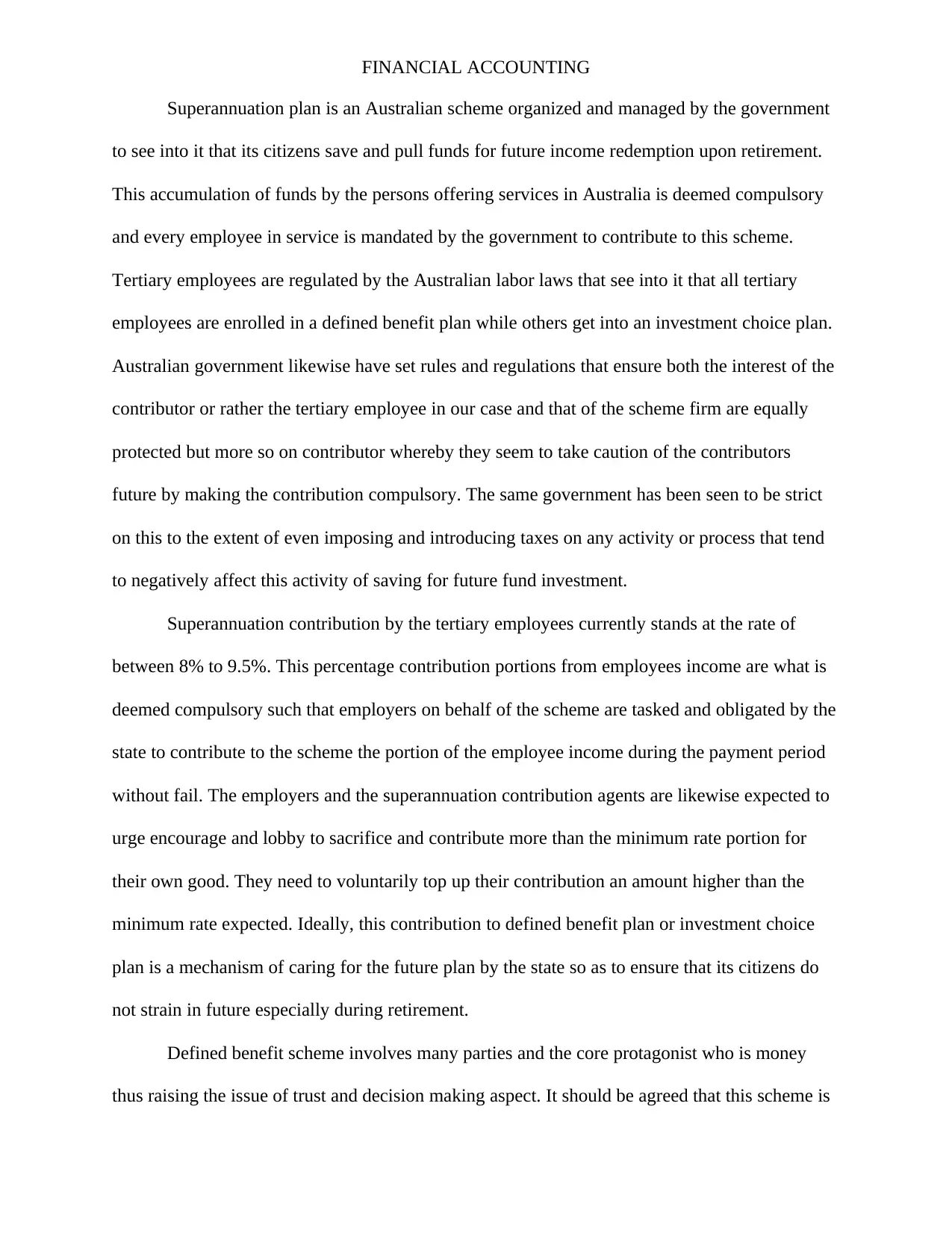
FINANCIAL ACCOUNTING
Superannuation plan is an Australian scheme organized and managed by the government
to see into it that its citizens save and pull funds for future income redemption upon retirement.
This accumulation of funds by the persons offering services in Australia is deemed compulsory
and every employee in service is mandated by the government to contribute to this scheme.
Tertiary employees are regulated by the Australian labor laws that see into it that all tertiary
employees are enrolled in a defined benefit plan while others get into an investment choice plan.
Australian government likewise have set rules and regulations that ensure both the interest of the
contributor or rather the tertiary employee in our case and that of the scheme firm are equally
protected but more so on contributor whereby they seem to take caution of the contributors
future by making the contribution compulsory. The same government has been seen to be strict
on this to the extent of even imposing and introducing taxes on any activity or process that tend
to negatively affect this activity of saving for future fund investment.
Superannuation contribution by the tertiary employees currently stands at the rate of
between 8% to 9.5%. This percentage contribution portions from employees income are what is
deemed compulsory such that employers on behalf of the scheme are tasked and obligated by the
state to contribute to the scheme the portion of the employee income during the payment period
without fail. The employers and the superannuation contribution agents are likewise expected to
urge encourage and lobby to sacrifice and contribute more than the minimum rate portion for
their own good. They need to voluntarily top up their contribution an amount higher than the
minimum rate expected. Ideally, this contribution to defined benefit plan or investment choice
plan is a mechanism of caring for the future plan by the state so as to ensure that its citizens do
not strain in future especially during retirement.
Defined benefit scheme involves many parties and the core protagonist who is money
thus raising the issue of trust and decision making aspect. It should be agreed that this scheme is
Superannuation plan is an Australian scheme organized and managed by the government
to see into it that its citizens save and pull funds for future income redemption upon retirement.
This accumulation of funds by the persons offering services in Australia is deemed compulsory
and every employee in service is mandated by the government to contribute to this scheme.
Tertiary employees are regulated by the Australian labor laws that see into it that all tertiary
employees are enrolled in a defined benefit plan while others get into an investment choice plan.
Australian government likewise have set rules and regulations that ensure both the interest of the
contributor or rather the tertiary employee in our case and that of the scheme firm are equally
protected but more so on contributor whereby they seem to take caution of the contributors
future by making the contribution compulsory. The same government has been seen to be strict
on this to the extent of even imposing and introducing taxes on any activity or process that tend
to negatively affect this activity of saving for future fund investment.
Superannuation contribution by the tertiary employees currently stands at the rate of
between 8% to 9.5%. This percentage contribution portions from employees income are what is
deemed compulsory such that employers on behalf of the scheme are tasked and obligated by the
state to contribute to the scheme the portion of the employee income during the payment period
without fail. The employers and the superannuation contribution agents are likewise expected to
urge encourage and lobby to sacrifice and contribute more than the minimum rate portion for
their own good. They need to voluntarily top up their contribution an amount higher than the
minimum rate expected. Ideally, this contribution to defined benefit plan or investment choice
plan is a mechanism of caring for the future plan by the state so as to ensure that its citizens do
not strain in future especially during retirement.
Defined benefit scheme involves many parties and the core protagonist who is money
thus raising the issue of trust and decision making aspect. It should be agreed that this scheme is
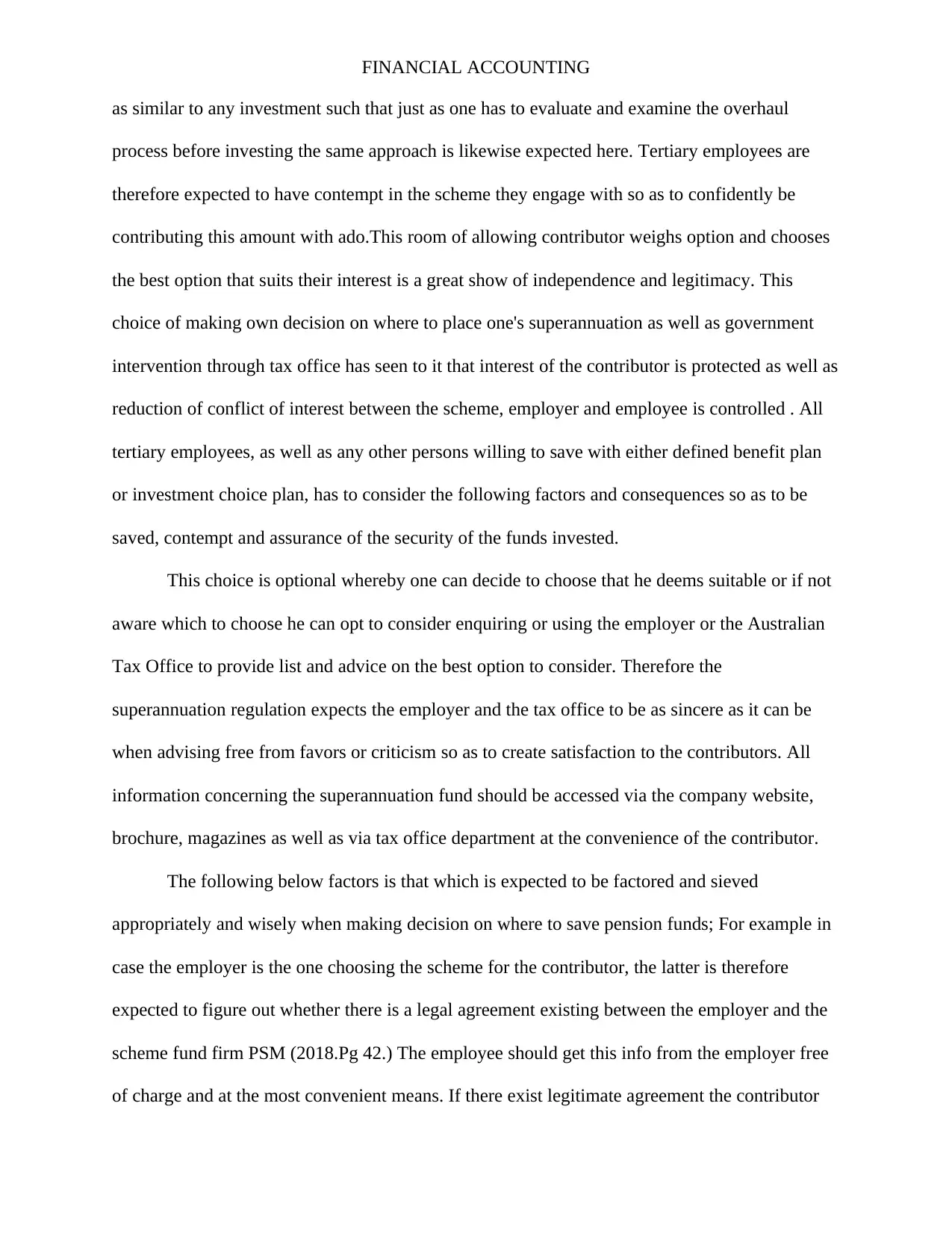
FINANCIAL ACCOUNTING
as similar to any investment such that just as one has to evaluate and examine the overhaul
process before investing the same approach is likewise expected here. Tertiary employees are
therefore expected to have contempt in the scheme they engage with so as to confidently be
contributing this amount with ado.This room of allowing contributor weighs option and chooses
the best option that suits their interest is a great show of independence and legitimacy. This
choice of making own decision on where to place one's superannuation as well as government
intervention through tax office has seen to it that interest of the contributor is protected as well as
reduction of conflict of interest between the scheme, employer and employee is controlled . All
tertiary employees, as well as any other persons willing to save with either defined benefit plan
or investment choice plan, has to consider the following factors and consequences so as to be
saved, contempt and assurance of the security of the funds invested.
This choice is optional whereby one can decide to choose that he deems suitable or if not
aware which to choose he can opt to consider enquiring or using the employer or the Australian
Tax Office to provide list and advice on the best option to consider. Therefore the
superannuation regulation expects the employer and the tax office to be as sincere as it can be
when advising free from favors or criticism so as to create satisfaction to the contributors. All
information concerning the superannuation fund should be accessed via the company website,
brochure, magazines as well as via tax office department at the convenience of the contributor.
The following below factors is that which is expected to be factored and sieved
appropriately and wisely when making decision on where to save pension funds; For example in
case the employer is the one choosing the scheme for the contributor, the latter is therefore
expected to figure out whether there is a legal agreement existing between the employer and the
scheme fund firm PSM (2018.Pg 42.) The employee should get this info from the employer free
of charge and at the most convenient means. If there exist legitimate agreement the contributor
as similar to any investment such that just as one has to evaluate and examine the overhaul
process before investing the same approach is likewise expected here. Tertiary employees are
therefore expected to have contempt in the scheme they engage with so as to confidently be
contributing this amount with ado.This room of allowing contributor weighs option and chooses
the best option that suits their interest is a great show of independence and legitimacy. This
choice of making own decision on where to place one's superannuation as well as government
intervention through tax office has seen to it that interest of the contributor is protected as well as
reduction of conflict of interest between the scheme, employer and employee is controlled . All
tertiary employees, as well as any other persons willing to save with either defined benefit plan
or investment choice plan, has to consider the following factors and consequences so as to be
saved, contempt and assurance of the security of the funds invested.
This choice is optional whereby one can decide to choose that he deems suitable or if not
aware which to choose he can opt to consider enquiring or using the employer or the Australian
Tax Office to provide list and advice on the best option to consider. Therefore the
superannuation regulation expects the employer and the tax office to be as sincere as it can be
when advising free from favors or criticism so as to create satisfaction to the contributors. All
information concerning the superannuation fund should be accessed via the company website,
brochure, magazines as well as via tax office department at the convenience of the contributor.
The following below factors is that which is expected to be factored and sieved
appropriately and wisely when making decision on where to save pension funds; For example in
case the employer is the one choosing the scheme for the contributor, the latter is therefore
expected to figure out whether there is a legal agreement existing between the employer and the
scheme fund firm PSM (2018.Pg 42.) The employee should get this info from the employer free
of charge and at the most convenient means. If there exist legitimate agreement the contributor
⊘ This is a preview!⊘
Do you want full access?
Subscribe today to unlock all pages.

Trusted by 1+ million students worldwide
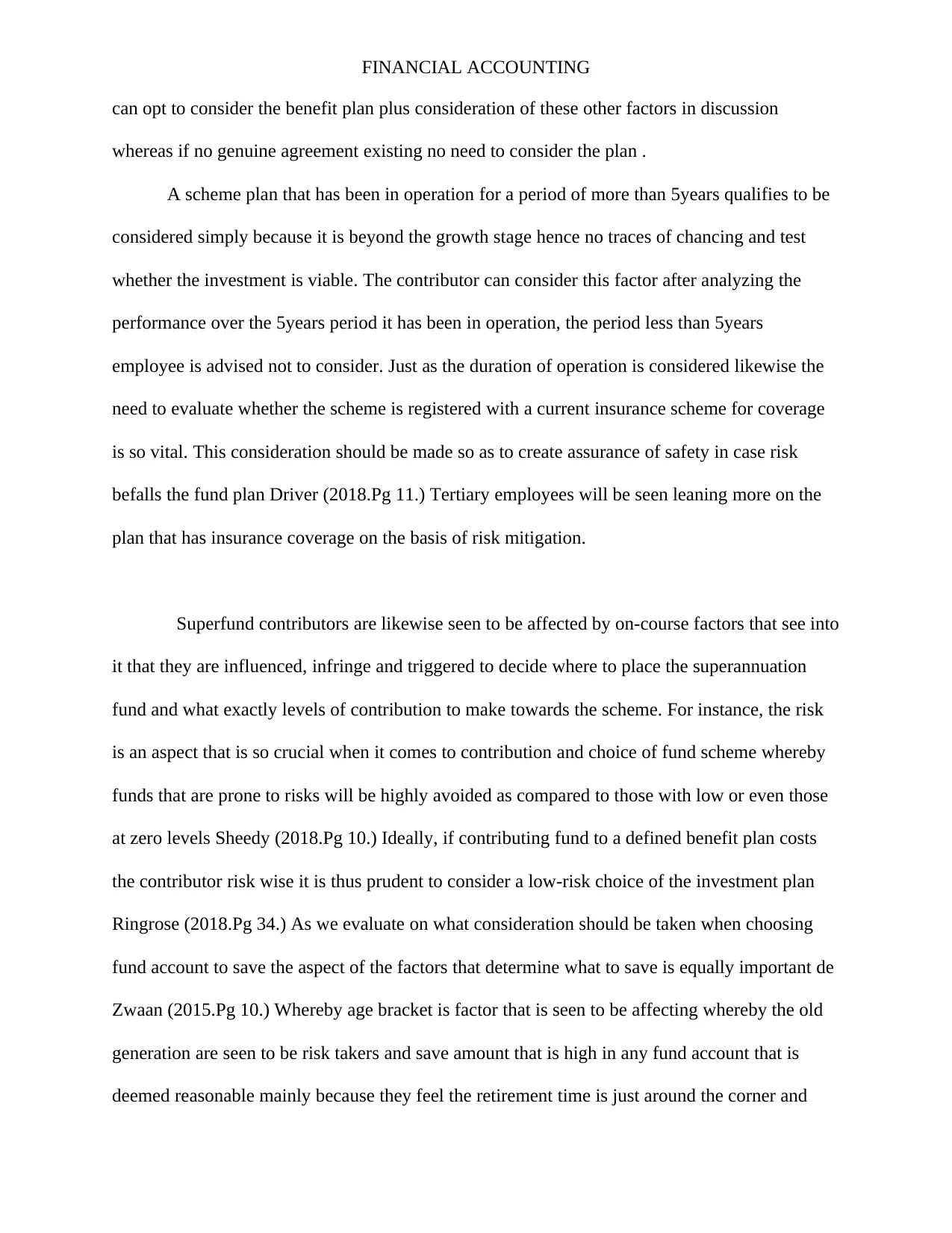
FINANCIAL ACCOUNTING
can opt to consider the benefit plan plus consideration of these other factors in discussion
whereas if no genuine agreement existing no need to consider the plan .
A scheme plan that has been in operation for a period of more than 5years qualifies to be
considered simply because it is beyond the growth stage hence no traces of chancing and test
whether the investment is viable. The contributor can consider this factor after analyzing the
performance over the 5years period it has been in operation, the period less than 5years
employee is advised not to consider. Just as the duration of operation is considered likewise the
need to evaluate whether the scheme is registered with a current insurance scheme for coverage
is so vital. This consideration should be made so as to create assurance of safety in case risk
befalls the fund plan Driver (2018.Pg 11.) Tertiary employees will be seen leaning more on the
plan that has insurance coverage on the basis of risk mitigation.
Superfund contributors are likewise seen to be affected by on-course factors that see into
it that they are influenced, infringe and triggered to decide where to place the superannuation
fund and what exactly levels of contribution to make towards the scheme. For instance, the risk
is an aspect that is so crucial when it comes to contribution and choice of fund scheme whereby
funds that are prone to risks will be highly avoided as compared to those with low or even those
at zero levels Sheedy (2018.Pg 10.) Ideally, if contributing fund to a defined benefit plan costs
the contributor risk wise it is thus prudent to consider a low-risk choice of the investment plan
Ringrose (2018.Pg 34.) As we evaluate on what consideration should be taken when choosing
fund account to save the aspect of the factors that determine what to save is equally important de
Zwaan (2015.Pg 10.) Whereby age bracket is factor that is seen to be affecting whereby the old
generation are seen to be risk takers and save amount that is high in any fund account that is
deemed reasonable mainly because they feel the retirement time is just around the corner and
can opt to consider the benefit plan plus consideration of these other factors in discussion
whereas if no genuine agreement existing no need to consider the plan .
A scheme plan that has been in operation for a period of more than 5years qualifies to be
considered simply because it is beyond the growth stage hence no traces of chancing and test
whether the investment is viable. The contributor can consider this factor after analyzing the
performance over the 5years period it has been in operation, the period less than 5years
employee is advised not to consider. Just as the duration of operation is considered likewise the
need to evaluate whether the scheme is registered with a current insurance scheme for coverage
is so vital. This consideration should be made so as to create assurance of safety in case risk
befalls the fund plan Driver (2018.Pg 11.) Tertiary employees will be seen leaning more on the
plan that has insurance coverage on the basis of risk mitigation.
Superfund contributors are likewise seen to be affected by on-course factors that see into
it that they are influenced, infringe and triggered to decide where to place the superannuation
fund and what exactly levels of contribution to make towards the scheme. For instance, the risk
is an aspect that is so crucial when it comes to contribution and choice of fund scheme whereby
funds that are prone to risks will be highly avoided as compared to those with low or even those
at zero levels Sheedy (2018.Pg 10.) Ideally, if contributing fund to a defined benefit plan costs
the contributor risk wise it is thus prudent to consider a low-risk choice of the investment plan
Ringrose (2018.Pg 34.) As we evaluate on what consideration should be taken when choosing
fund account to save the aspect of the factors that determine what to save is equally important de
Zwaan (2015.Pg 10.) Whereby age bracket is factor that is seen to be affecting whereby the old
generation are seen to be risk takers and save amount that is high in any fund account that is
deemed reasonable mainly because they feel the retirement time is just around the corner and
Paraphrase This Document
Need a fresh take? Get an instant paraphrase of this document with our AI Paraphraser
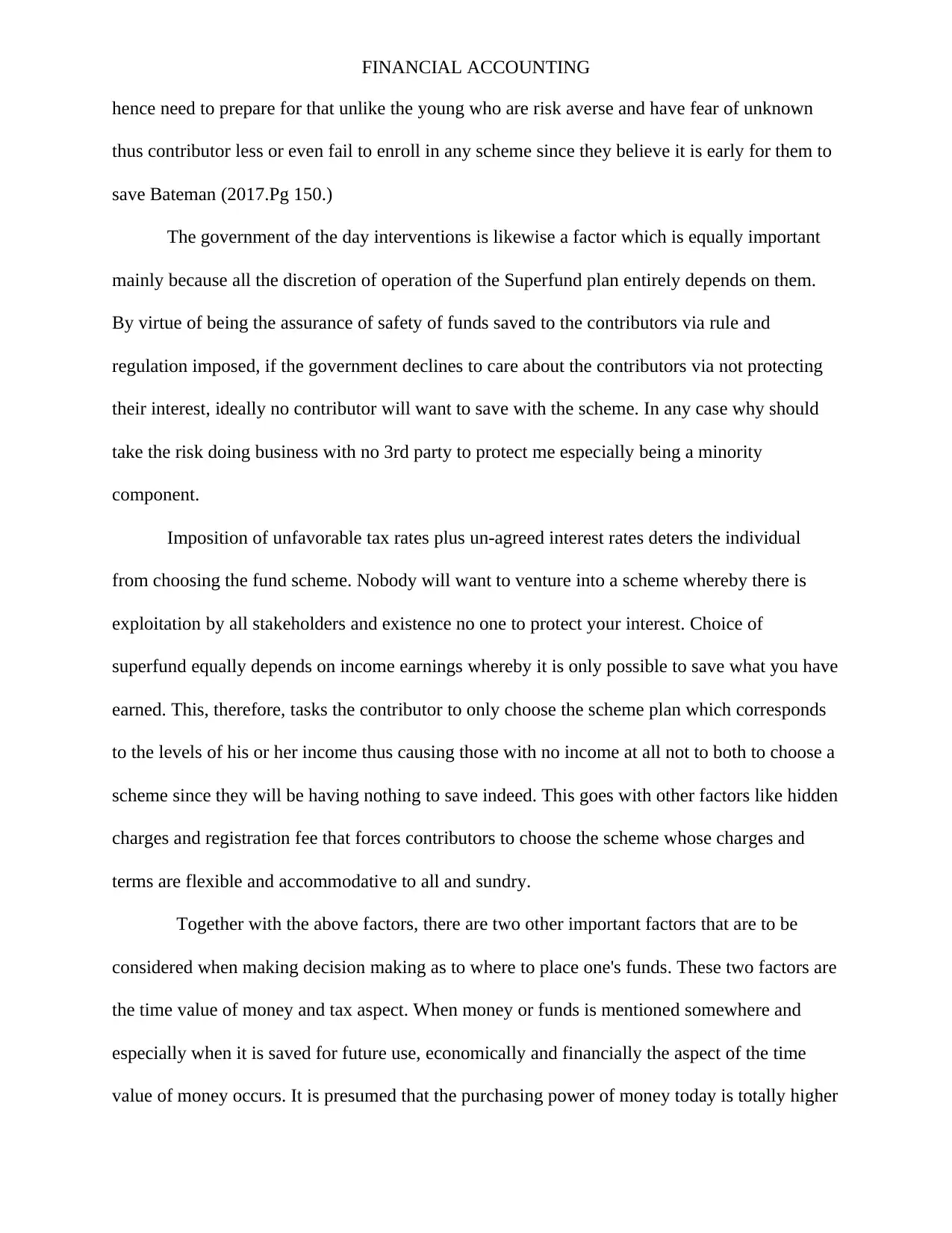
FINANCIAL ACCOUNTING
hence need to prepare for that unlike the young who are risk averse and have fear of unknown
thus contributor less or even fail to enroll in any scheme since they believe it is early for them to
save Bateman (2017.Pg 150.)
The government of the day interventions is likewise a factor which is equally important
mainly because all the discretion of operation of the Superfund plan entirely depends on them.
By virtue of being the assurance of safety of funds saved to the contributors via rule and
regulation imposed, if the government declines to care about the contributors via not protecting
their interest, ideally no contributor will want to save with the scheme. In any case why should
take the risk doing business with no 3rd party to protect me especially being a minority
component.
Imposition of unfavorable tax rates plus un-agreed interest rates deters the individual
from choosing the fund scheme. Nobody will want to venture into a scheme whereby there is
exploitation by all stakeholders and existence no one to protect your interest. Choice of
superfund equally depends on income earnings whereby it is only possible to save what you have
earned. This, therefore, tasks the contributor to only choose the scheme plan which corresponds
to the levels of his or her income thus causing those with no income at all not to both to choose a
scheme since they will be having nothing to save indeed. This goes with other factors like hidden
charges and registration fee that forces contributors to choose the scheme whose charges and
terms are flexible and accommodative to all and sundry.
Together with the above factors, there are two other important factors that are to be
considered when making decision making as to where to place one's funds. These two factors are
the time value of money and tax aspect. When money or funds is mentioned somewhere and
especially when it is saved for future use, economically and financially the aspect of the time
value of money occurs. It is presumed that the purchasing power of money today is totally higher
hence need to prepare for that unlike the young who are risk averse and have fear of unknown
thus contributor less or even fail to enroll in any scheme since they believe it is early for them to
save Bateman (2017.Pg 150.)
The government of the day interventions is likewise a factor which is equally important
mainly because all the discretion of operation of the Superfund plan entirely depends on them.
By virtue of being the assurance of safety of funds saved to the contributors via rule and
regulation imposed, if the government declines to care about the contributors via not protecting
their interest, ideally no contributor will want to save with the scheme. In any case why should
take the risk doing business with no 3rd party to protect me especially being a minority
component.
Imposition of unfavorable tax rates plus un-agreed interest rates deters the individual
from choosing the fund scheme. Nobody will want to venture into a scheme whereby there is
exploitation by all stakeholders and existence no one to protect your interest. Choice of
superfund equally depends on income earnings whereby it is only possible to save what you have
earned. This, therefore, tasks the contributor to only choose the scheme plan which corresponds
to the levels of his or her income thus causing those with no income at all not to both to choose a
scheme since they will be having nothing to save indeed. This goes with other factors like hidden
charges and registration fee that forces contributors to choose the scheme whose charges and
terms are flexible and accommodative to all and sundry.
Together with the above factors, there are two other important factors that are to be
considered when making decision making as to where to place one's funds. These two factors are
the time value of money and tax aspect. When money or funds is mentioned somewhere and
especially when it is saved for future use, economically and financially the aspect of the time
value of money occurs. It is presumed that the purchasing power of money today is totally higher
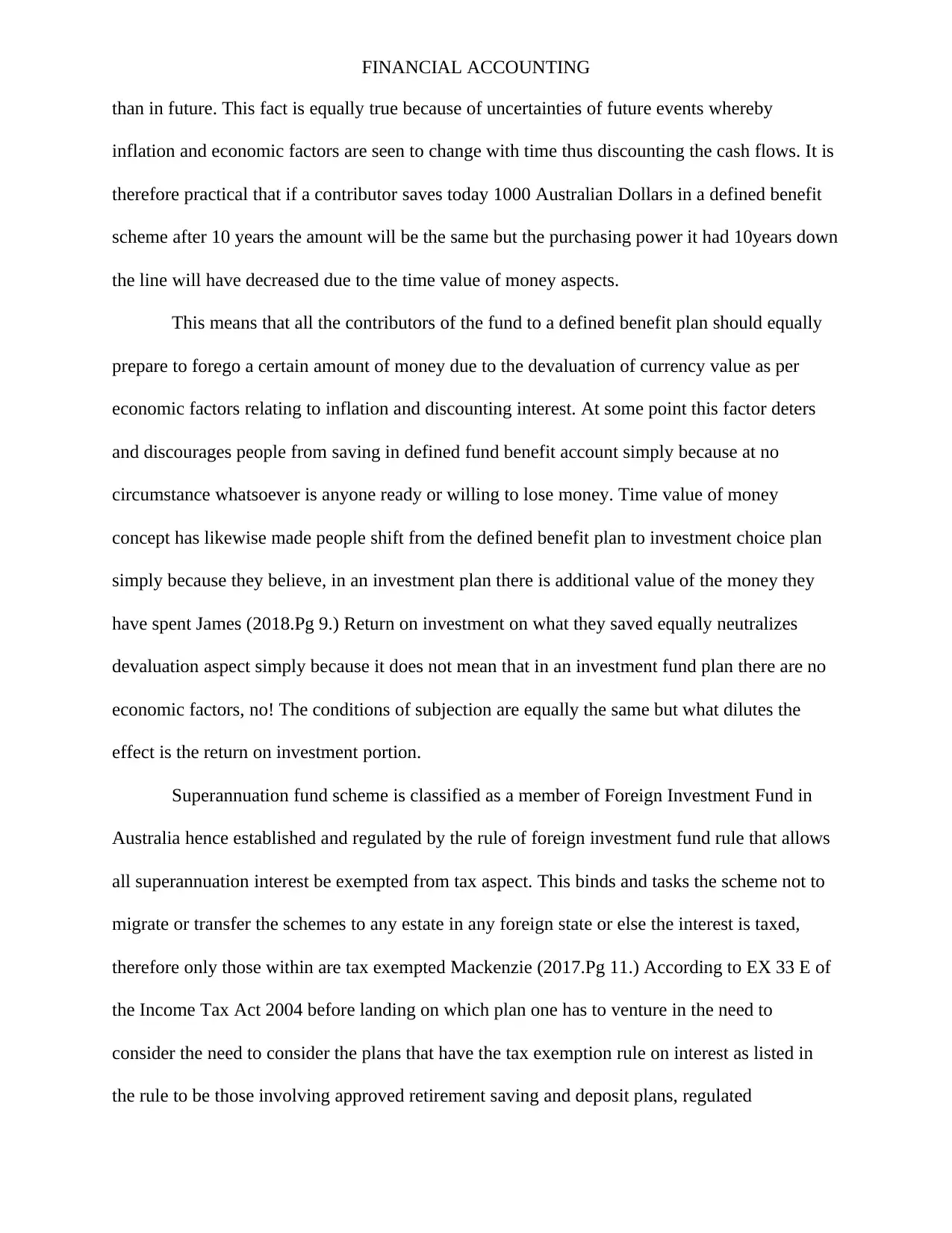
FINANCIAL ACCOUNTING
than in future. This fact is equally true because of uncertainties of future events whereby
inflation and economic factors are seen to change with time thus discounting the cash flows. It is
therefore practical that if a contributor saves today 1000 Australian Dollars in a defined benefit
scheme after 10 years the amount will be the same but the purchasing power it had 10years down
the line will have decreased due to the time value of money aspects.
This means that all the contributors of the fund to a defined benefit plan should equally
prepare to forego a certain amount of money due to the devaluation of currency value as per
economic factors relating to inflation and discounting interest. At some point this factor deters
and discourages people from saving in defined fund benefit account simply because at no
circumstance whatsoever is anyone ready or willing to lose money. Time value of money
concept has likewise made people shift from the defined benefit plan to investment choice plan
simply because they believe, in an investment plan there is additional value of the money they
have spent James (2018.Pg 9.) Return on investment on what they saved equally neutralizes
devaluation aspect simply because it does not mean that in an investment fund plan there are no
economic factors, no! The conditions of subjection are equally the same but what dilutes the
effect is the return on investment portion.
Superannuation fund scheme is classified as a member of Foreign Investment Fund in
Australia hence established and regulated by the rule of foreign investment fund rule that allows
all superannuation interest be exempted from tax aspect. This binds and tasks the scheme not to
migrate or transfer the schemes to any estate in any foreign state or else the interest is taxed,
therefore only those within are tax exempted Mackenzie (2017.Pg 11.) According to EX 33 E of
the Income Tax Act 2004 before landing on which plan one has to venture in the need to
consider the need to consider the plans that have the tax exemption rule on interest as listed in
the rule to be those involving approved retirement saving and deposit plans, regulated
than in future. This fact is equally true because of uncertainties of future events whereby
inflation and economic factors are seen to change with time thus discounting the cash flows. It is
therefore practical that if a contributor saves today 1000 Australian Dollars in a defined benefit
scheme after 10 years the amount will be the same but the purchasing power it had 10years down
the line will have decreased due to the time value of money aspects.
This means that all the contributors of the fund to a defined benefit plan should equally
prepare to forego a certain amount of money due to the devaluation of currency value as per
economic factors relating to inflation and discounting interest. At some point this factor deters
and discourages people from saving in defined fund benefit account simply because at no
circumstance whatsoever is anyone ready or willing to lose money. Time value of money
concept has likewise made people shift from the defined benefit plan to investment choice plan
simply because they believe, in an investment plan there is additional value of the money they
have spent James (2018.Pg 9.) Return on investment on what they saved equally neutralizes
devaluation aspect simply because it does not mean that in an investment fund plan there are no
economic factors, no! The conditions of subjection are equally the same but what dilutes the
effect is the return on investment portion.
Superannuation fund scheme is classified as a member of Foreign Investment Fund in
Australia hence established and regulated by the rule of foreign investment fund rule that allows
all superannuation interest be exempted from tax aspect. This binds and tasks the scheme not to
migrate or transfer the schemes to any estate in any foreign state or else the interest is taxed,
therefore only those within are tax exempted Mackenzie (2017.Pg 11.) According to EX 33 E of
the Income Tax Act 2004 before landing on which plan one has to venture in the need to
consider the need to consider the plans that have the tax exemption rule on interest as listed in
the rule to be those involving approved retirement saving and deposit plans, regulated
⊘ This is a preview!⊘
Do you want full access?
Subscribe today to unlock all pages.

Trusted by 1+ million students worldwide
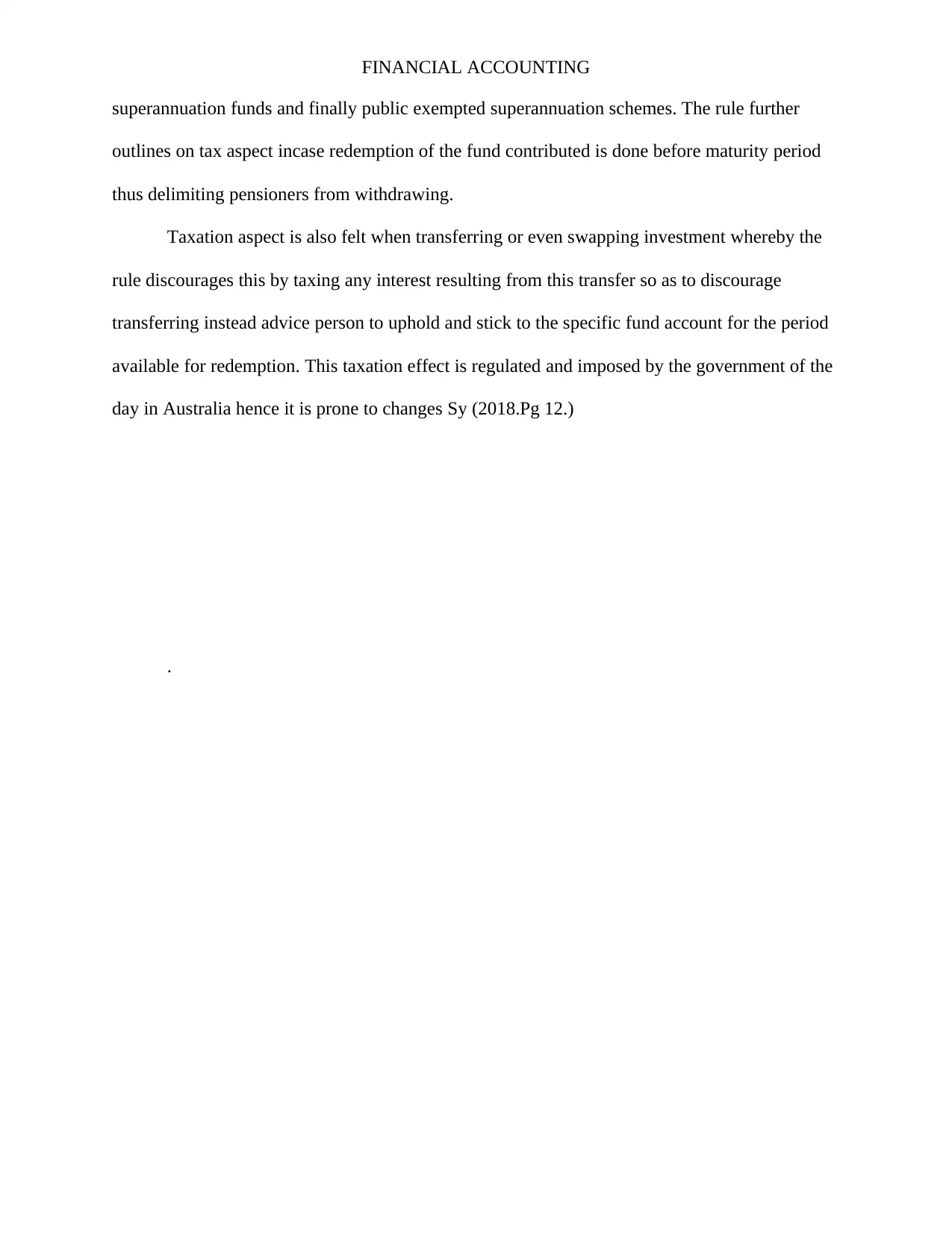
FINANCIAL ACCOUNTING
superannuation funds and finally public exempted superannuation schemes. The rule further
outlines on tax aspect incase redemption of the fund contributed is done before maturity period
thus delimiting pensioners from withdrawing.
Taxation aspect is also felt when transferring or even swapping investment whereby the
rule discourages this by taxing any interest resulting from this transfer so as to discourage
transferring instead advice person to uphold and stick to the specific fund account for the period
available for redemption. This taxation effect is regulated and imposed by the government of the
day in Australia hence it is prone to changes Sy (2018.Pg 12.)
.
superannuation funds and finally public exempted superannuation schemes. The rule further
outlines on tax aspect incase redemption of the fund contributed is done before maturity period
thus delimiting pensioners from withdrawing.
Taxation aspect is also felt when transferring or even swapping investment whereby the
rule discourages this by taxing any interest resulting from this transfer so as to discourage
transferring instead advice person to uphold and stick to the specific fund account for the period
available for redemption. This taxation effect is regulated and imposed by the government of the
day in Australia hence it is prone to changes Sy (2018.Pg 12.)
.
Paraphrase This Document
Need a fresh take? Get an instant paraphrase of this document with our AI Paraphraser
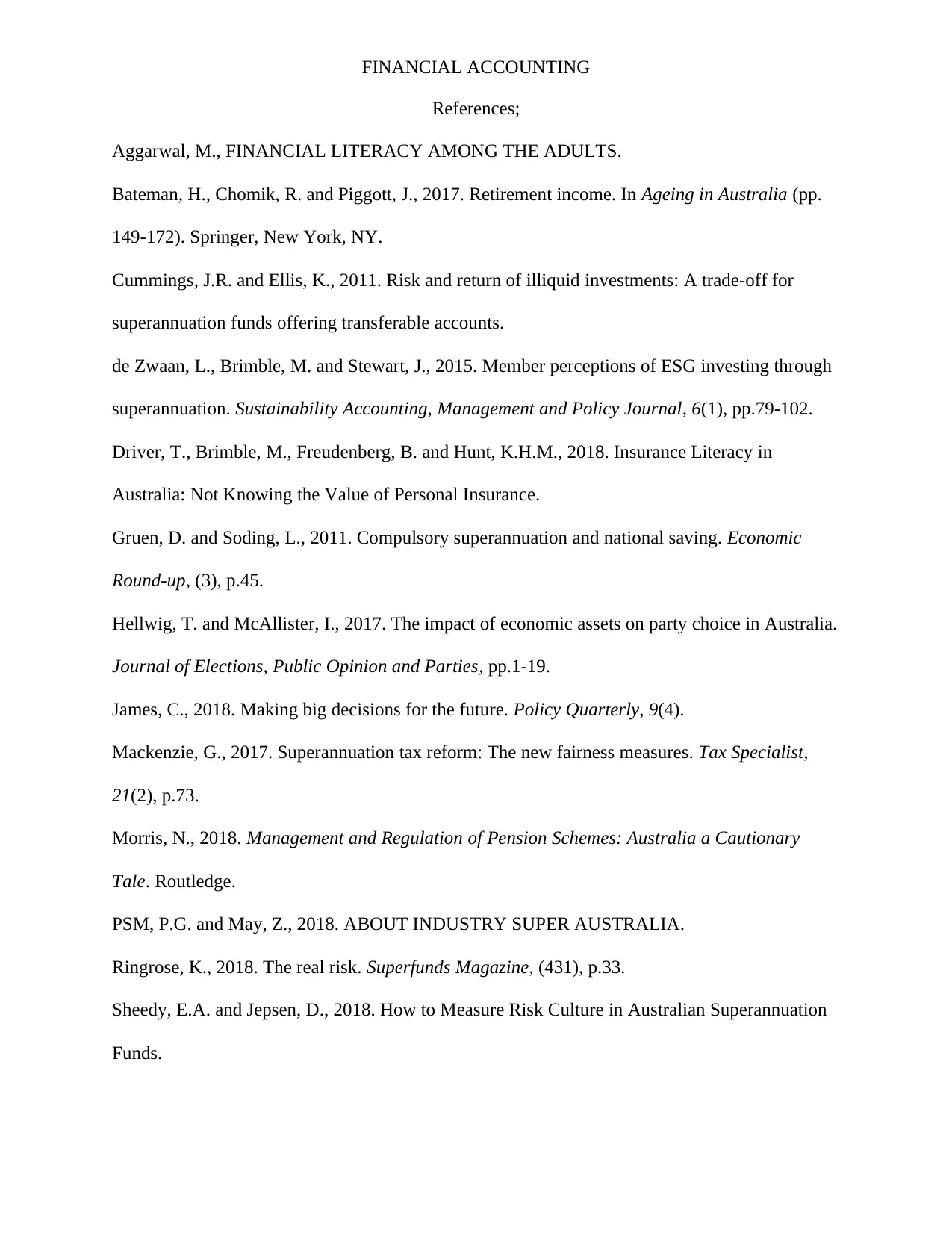
FINANCIAL ACCOUNTING
References;
Aggarwal, M., FINANCIAL LITERACY AMONG THE ADULTS.
Bateman, H., Chomik, R. and Piggott, J., 2017. Retirement income. In Ageing in Australia (pp.
149-172). Springer, New York, NY.
Cummings, J.R. and Ellis, K., 2011. Risk and return of illiquid investments: A trade-off for
superannuation funds offering transferable accounts.
de Zwaan, L., Brimble, M. and Stewart, J., 2015. Member perceptions of ESG investing through
superannuation. Sustainability Accounting, Management and Policy Journal, 6(1), pp.79-102.
Driver, T., Brimble, M., Freudenberg, B. and Hunt, K.H.M., 2018. Insurance Literacy in
Australia: Not Knowing the Value of Personal Insurance.
Gruen, D. and Soding, L., 2011. Compulsory superannuation and national saving. Economic
Round-up, (3), p.45.
Hellwig, T. and McAllister, I., 2017. The impact of economic assets on party choice in Australia.
Journal of Elections, Public Opinion and Parties, pp.1-19.
James, C., 2018. Making big decisions for the future. Policy Quarterly, 9(4).
Mackenzie, G., 2017. Superannuation tax reform: The new fairness measures. Tax Specialist,
21(2), p.73.
Morris, N., 2018. Management and Regulation of Pension Schemes: Australia a Cautionary
Tale. Routledge.
PSM, P.G. and May, Z., 2018. ABOUT INDUSTRY SUPER AUSTRALIA.
Ringrose, K., 2018. The real risk. Superfunds Magazine, (431), p.33.
Sheedy, E.A. and Jepsen, D., 2018. How to Measure Risk Culture in Australian Superannuation
Funds.
References;
Aggarwal, M., FINANCIAL LITERACY AMONG THE ADULTS.
Bateman, H., Chomik, R. and Piggott, J., 2017. Retirement income. In Ageing in Australia (pp.
149-172). Springer, New York, NY.
Cummings, J.R. and Ellis, K., 2011. Risk and return of illiquid investments: A trade-off for
superannuation funds offering transferable accounts.
de Zwaan, L., Brimble, M. and Stewart, J., 2015. Member perceptions of ESG investing through
superannuation. Sustainability Accounting, Management and Policy Journal, 6(1), pp.79-102.
Driver, T., Brimble, M., Freudenberg, B. and Hunt, K.H.M., 2018. Insurance Literacy in
Australia: Not Knowing the Value of Personal Insurance.
Gruen, D. and Soding, L., 2011. Compulsory superannuation and national saving. Economic
Round-up, (3), p.45.
Hellwig, T. and McAllister, I., 2017. The impact of economic assets on party choice in Australia.
Journal of Elections, Public Opinion and Parties, pp.1-19.
James, C., 2018. Making big decisions for the future. Policy Quarterly, 9(4).
Mackenzie, G., 2017. Superannuation tax reform: The new fairness measures. Tax Specialist,
21(2), p.73.
Morris, N., 2018. Management and Regulation of Pension Schemes: Australia a Cautionary
Tale. Routledge.
PSM, P.G. and May, Z., 2018. ABOUT INDUSTRY SUPER AUSTRALIA.
Ringrose, K., 2018. The real risk. Superfunds Magazine, (431), p.33.
Sheedy, E.A. and Jepsen, D., 2018. How to Measure Risk Culture in Australian Superannuation
Funds.
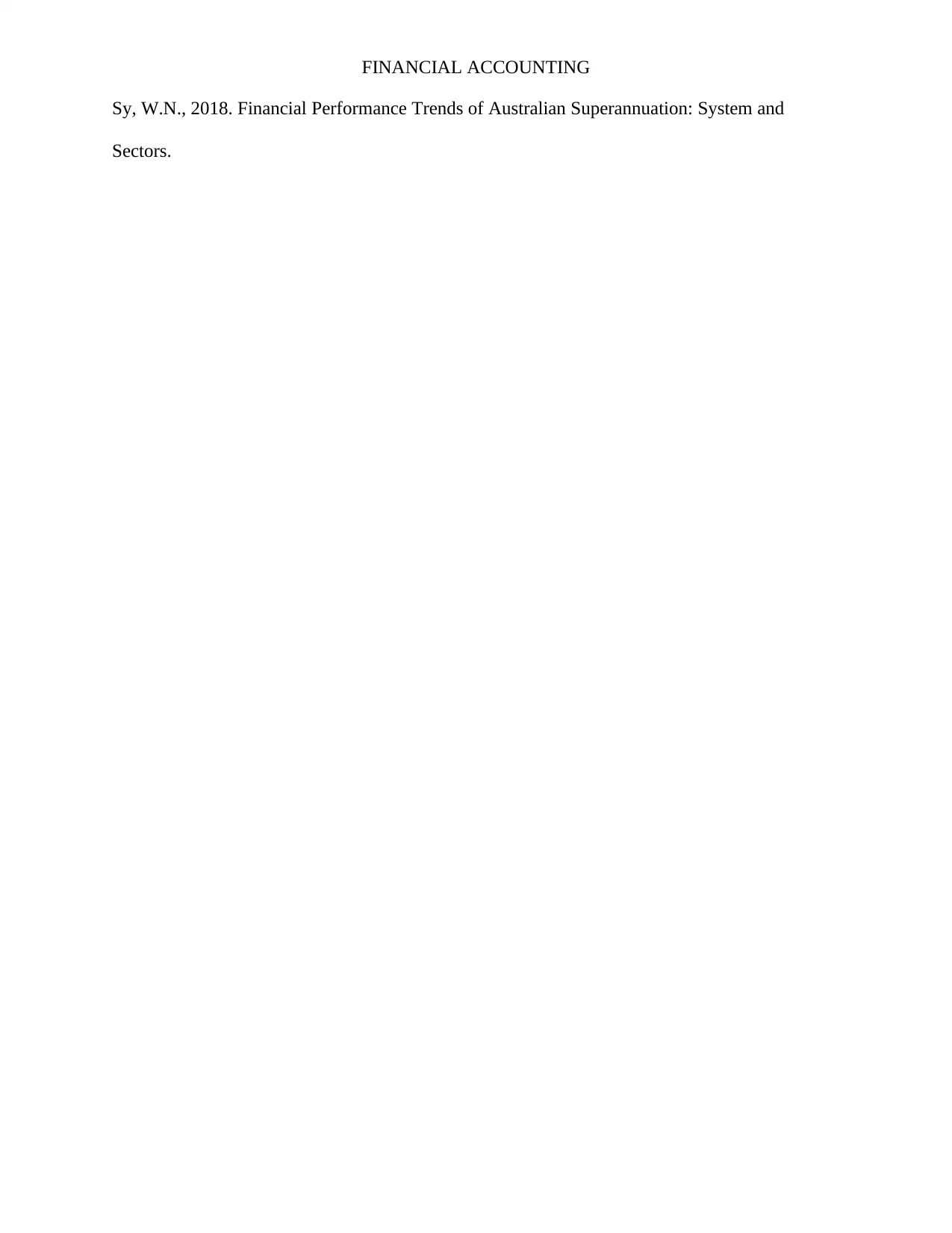
FINANCIAL ACCOUNTING
Sy, W.N., 2018. Financial Performance Trends of Australian Superannuation: System and
Sectors.
Sy, W.N., 2018. Financial Performance Trends of Australian Superannuation: System and
Sectors.
⊘ This is a preview!⊘
Do you want full access?
Subscribe today to unlock all pages.

Trusted by 1+ million students worldwide
1 out of 9
Related Documents
Your All-in-One AI-Powered Toolkit for Academic Success.
+13062052269
info@desklib.com
Available 24*7 on WhatsApp / Email
![[object Object]](/_next/static/media/star-bottom.7253800d.svg)
Unlock your academic potential
Copyright © 2020–2025 A2Z Services. All Rights Reserved. Developed and managed by ZUCOL.




